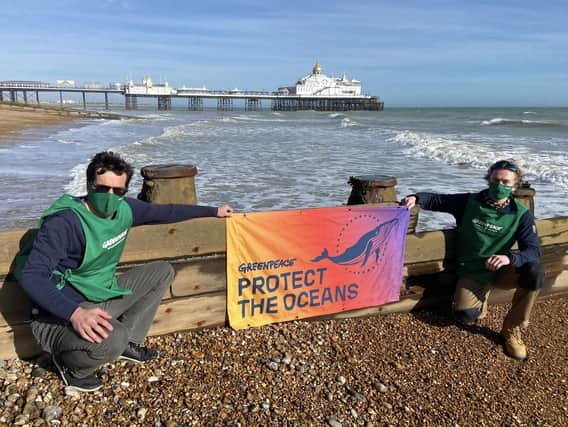Greenpeace demand bottom trawler ban as they build underwater boulder barrier off the coast of Sussex


Activists on the Greenpeace ship Esperanza are currently building a new underwater boulder barrier in the offshore Brighton marine protected area, one of the UK’s most heavily bottom trawled protected areas according to the group.
This follows Greenpeace’s Dogger Bank boulder barrier and will close 55 square nautical miles of offshore Sussex one-fifth of its total area, to bottom trawling.
Advertisement
Hide AdAdvertisement
Hide AdBottom trawling is when a net is dragged across the sea floor in order to catch marine life.
Greenpeace say their problem with bottom trawling is that it has an impact on the biodiversity of the area as it catches marine life that was not originally targeted.
The boulder barrier is created by large rocks being placed on the seabed and will disrupt bottom trawling.
Celebrities including Thandie Newton, Hugh Fearnley-Whittingstall, Paloma Faith, Bella Ramsey, Mark Rylance, Jarvis Cocker and Ranulph Fiennes have signed their names to boulders.
Advertisement
Hide AdAdvertisement
Hide AdAccording to Greenpeace, in response to the Dogger Bank boulder barrier, the UK government announced new bylaws which would totally close the protected areas in South Dorset and by the boulder barrier, and partially close two other protected areas, to bottom trawling.
The group have also said this approach would still leave 97 per cent of UK offshore protected areas, 74 out of 76, fully or partially open to bottom trawling.
According to Greenpeace bottom trawlers spent 3099 hours fishing in offshore Brighton in 2019.
The environmental group has also said that according to the government, offshore Brighton is “unlikely to be moving towards conservation objectives.”
Advertisement
Hide AdAdvertisement
Hide AdGreenpeace said that last year 84 MPs from across Parliament, including Eastbourne MP Caroline Ansell, signed an open letter calling on the Secretary of State George Eustice to ban destructive industrial fishing from UK marine protected areas.
This was previously difficult because introducing restrictions on fishing operations in offshore UK waters required agreement from other EU member states.
Chris Thorne, an oceans campaigner at Greenpeace UK, says that the move ‘barely touches the tip of the iceberg in terms of what is needed to save our oceans’.
Hugh Fearnley-Whittingstall, who was at sea to witness Greenpeace deploying the boulders, said, “I’m proud to have had the chance to put my name on one of these boulders, and to be there today to bear witness to the creation of this boulder barrier. This action will play a small but significant role.”
Advertisement
Hide AdAdvertisement
Hide AdMost of the UK’s protected areas in offshore waters (those more than 12 nautical miles from the coast) were established to protect the seabed. Currently, according to Greenpeace, there are no full bottom trawling bans in any of the UK’s offshore protected areas and that data released by Oceana last year revealed 97 per cent of the UK’s offshore marine protected areas are being bottom trawled.
Greenpeace informed the relevant marine authorities of the precise coordinates of each boulder to ensure navigational safety for other seafarers and the environmental group also commissioned an independent scientific agency, BioLaGu, to conduct a natura 2000 environmental impact assessment to determine the impact of this activity.
Greenpeace said the assessment concluded the activity would not have a significant impact on the protected features of offshore Brighton.
A network of fully or highly protected marine areas would help UK fishing communities by ensuring there are healthy oceans, full of fish, for generations to come, according to the group.
For more information on Greenpeace and their cause click here.